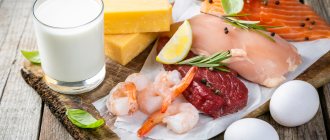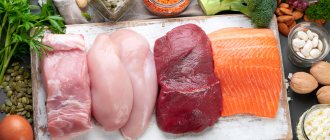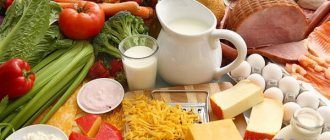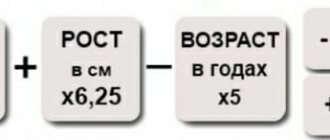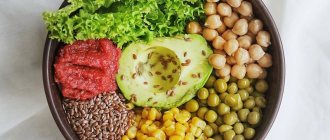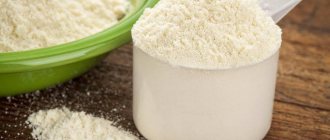Nutrition is the comprehensive science of food and its effects on health. Nutrients that the body cannot synthesize itself must come from food. Nutrients necessary for normal functioning include:
- vitamins;
- minerals;
- amino acids;
- fatty acid.
The body needs some of these substances (microelements) in very small quantities, others, on the contrary, more (macroelements). A lack of any of the nutrients often causes the development of serious diseases. Excess often leads to obesity and side problems.
Macronutrients: Basics
Content:
- Macronutrients: Basics
- Carbohydrates are a tasty source of energy
- Monosaccharides and disaccharides
- Polysaccharides: starch, cellulose and resistant starch
- Energy sources
- What is the glycemic index
- Protein is the basis of everything
- What are amino acids?
- Fats and an undeserved bad reputation
- Types of fats
- Essential Omega-3 and Omega-6
- "Bad" fats
- Sources of Lipids in Foods
- How the body uses proteins, carbohydrates and fats
- Instead of an afterword
Macronutrients, or macronutrients, are nutrients that provide the body with the energy and calories it needs. They are necessary for normal growth, metabolism and maintenance of body functions.
Already based on the name, it becomes clear: macroelements are a group of substances necessary for humans in large quantities. Macronutrients include: proteins, fats, carbohydrates.
Many are puzzled by the question of what the percentage of these substances should be in the daily diet and how many grams of each element should be received daily. But to answer it, it is important to understand what these elements are and what functions they perform.
These three classes of macroelements are complex groups, each of which consists of many components. You can eat the same amount (in grams) of proteins, lipids and carbohydrates every day, but at the same time provide the body with different microelements each time, depending on the content of the substances.
For example, in identical portions of olive oil and lard, the lipids are radically different. Therefore, it is important to maintain a balanced diet and a varied diet to maintain harmony in the body. And immediately the first conclusion: it is not so much the quantity of consumption of useful micro- and macroelements that is important (although this is also an important nuance), but rather their quality.
But when it comes to the supply of calories, it is still worth remembering that the energy value in 1 gram is:
- carbohydrates – 4 calories;
- proteins – 4 calories;
- fat – 9 calories.
Let's start with history
“Calorie” as a term was formed in the 19th century; French thermochemists R.A. Favre and I.T. Zilberman introduced it into scientific circulation. Initially, the term was interpreted as a unit of calculating the heat of combustion.
In modern science, a calorie is a certain amount of heat, with the help of which the temperature of 1 gram of water increases by 1 degree Celsius. In everyday life, these measurements occur through calories—1 calorie equals 4.1868 joules.
However, when we come to the store, on the packaging of the products we find the energy value of the products per 100 grams, indicated in kilocalories. For understanding, 1 kilocalorie (kcal) is equal to 1 thousand calories.
Return to article content
Carbohydrates are a tasty source of energy
Carbohydrates are a combination of different molecules that provide approximately 45 percent of the body's energy. True, some types of carbohydrates, such as fiber and resistant starches, do not serve as a source of energy, but they play an equally important role:
- strengthen the health of the digestive system;
- promote easy digestion of food and absorption of nutrients;
- get rid of waste and toxins.
Functions in the body
Carbohydrates obtained from food are broken down into glucose and other monosaccharides. They increase plasma sugar levels and supply a person with energy. The role of most carbohydrates is that they:
- are an excellent source of nutrition;
- all cells and tissues of the body use them to obtain energy;
- accumulate in liver cells and muscle tissue in order to be activated when necessary;
- necessary for the functioning of the nervous system, brain, muscles (in particular the heart), kidneys;
- have a beneficial effect on maintaining intestinal health.
Carbohydrates are made up of carbon, hydrogen and oxygen. There are simple and complex carbohydrates.
Test your knowledge
If you want to test your knowledge on the topic of this lesson, you can take a short test consisting of several questions. For each question, only 1 option can be correct. After you select one of the options, the system automatically moves on to the next question. The points you receive are affected by the correctness of your answers and the time spent on completion. Please note that the questions are different each time and the options are mixed.
Statistics Full screen
Kirill Nogales
← Digestion Vitamins and microelements →
Monosaccharides and disaccharides
Simple carbohydrates consist of monosaccharides and disaccharides. They are able to quickly increase glucose levels. They taste sweet, are quickly absorbed, providing the body with energy, and quickly break down.
Monosaccharides are simple sugars because they consist of a single block. In this form they can be absorbed by the body. Unlike other carbohydrates, they do not require breakdown during digestion. Therefore, monosaccharides from food quickly enter the blood, almost instantly increasing the amount of sugar in the plasma, and immediately supplying energy to the body.
Examples of monosaccharides: glucose, fructose, galactose. Simple sugars are found in different quantities in foods from different categories. High content in ripe fruits and honey.
Monosaccharides are important sources of energy. But consuming large amounts of simple sugars without balancing them with polysaccharides or oligosaccharides (which take longer to digest and therefore provide the body with long-term energy) can cause a significant increase in blood glucose followed by a sharp drop in the level.
As a result, at first there is a large and sharp release of energy, which is also quickly replaced by a feeling of fatigue. Frequent repetition of such fluctuations can cause diabetes.
Disaccharides
Disaccharides are combinations of 2 monosaccharides. Disaccharides include:
- lactose (milk sugar);
- sucrose (table);
- maltose;
- isomaltose (sugar formed as a result of the breakdown of starch).
Disaccharides, like monosaccharides, give food a sweet taste and provide the body with quick energy. Due to these biochemical properties, they are also classified as simple sugars. They are present in large quantities in processed foods. Frequent consumption of disaccharides can also lead to increased blood glucose.
Since disaccharides contain 2 parts of sugar, they undergo a separation process before being absorbed into the body. Therefore, for each disaccharide the body has its own digestive enzyme. Thus, sucrase acts on sucrose, lactase acts on lactose. The necessary enzymes are produced in the intestines. The absorption of disaccharides is quite easy. The exception is lactose.
There are people who lack the lactase enzyme, which means their bodies are not able to break lactose into 2 elements, which manifests itself in the so-called lactose intolerance. This means that consuming dairy products is a problem for these people. Lactose intolerance is more common in old age.
Undigested milk sugar is not digested and contributes to the development of bacteria unfavorable for the body in the digestive tract. As a result, this leads to flatulence, heartburn and nausea. In addition, the acid produced by bacteria impairs the functioning of the intestines as a whole (reduces its ability to digest food) and damages the cells of the digestive system. It is important for such people to avoid foods that contain lactose. Some studies show that for such digestive disorders it is useful to use dietary supplements containing lactobacilli.
Other components
Adequate nutrition also depends on sufficient amounts of vitamins, minerals, dietary fiber, antioxidants and water. If the intake of some of these components from food is insufficient, it is possible to compensate for this by using biological food additives.
Vitamins
Vitamins are organic substances, some of which must be obtained from food, since they are either not synthesized in the body, or this occurs at a low rate. The exception is vitamin D, which is synthesized under the influence of ultraviolet radiation. Vitamins regulate the processes of metabolism, energy synthesis, nerve conduction, and help prevent cell destruction.
Vitamins can be grouped into:
- water-soluble (B, C), the reserves of which are small and require regular replenishment;
- fat-soluble (A, D, E, K), which accumulate in tissues and can be toxic.
Basically, people do not get enough vitamins due to the use of an incorrect diet, malnutrition (for example, due to lack of appetite or other reasons).
Minerals
Minerals participate in plastic and enzymatic processes, in protein synthesis and the formation of body tissues, regulate acid-base balance and water metabolism.
The most important are:
- Calcium. The main component of the skeletal system and teeth.
- Phosphorus. Necessary for bone mineralization.
- Magnesium. Necessary for phosphorus-calcium metabolism.
- Iron. Part of hemoglobin and oxidative enzymes.
- Potassium. Regulates the acid-base balance of the blood.
Water
Water makes up almost 60% of an adult's total body weight. It maintains constant body temperature and pressure, dissolves vital nutrients, helps absorb and transport nutrients, and remove waste.
Water replacement is vital. The amount of drinking water should be sufficient for normal kidney function. When it is deficient, muscle strength weakens, motor control deteriorates, mental energy decreases, and fatigue occurs. Dehydration can lead to deterioration of the entire body.
The required amount of daily water consumption ranges from 2.5 liters in winter to 3.5 liters in summer.
Polysaccharides: starch, cellulose and resistant starch
Large carbohydrate molecules (such as fiber or starch) are made up of several monosaccharides bound together. Some of them may contain up to several hundred mono-sugars. Such a complex is called polysaccharides (from “poly” - many). The specificity of complex compounds is that they increase glucose levels in the body more slowly, but act for a longer time. The group of complex carbohydrates consists of starches and fiber.
Plants store their energy by combining many mono-sugars. Such a complex can consist of hundreds (sometimes up to several thousand) glucose molecules. Plant products (for example, seeds, which are supposed to provide strength to shoots) contain a lot of starch. When a young plant begins to grow, starch is broken down into glucose and supplies it with the necessary energy.
Starch
If a person eats a starchy food such as corn or potatoes, the body uses the polysaccharides from it in much the same way as plants. The digestion of starches takes longer than the process of processing disaccharides.
Therefore, we can say that starch is a sustainable source of energy. It does not cause a sharp saturation of the blood with sugar; the effect of starch is slow, consistent and long-term maintenance of strength in the body. And it is considered a good health option.
There are 2 main types of starches in food:
- amylose;
- amylopectin.
Amylopectin is digested by the body faster. The process of absorption of food starches is preceded by the stage of breakdown of the substance into smaller elements - individual units of carbohydrates.
Cellulose (fiber)
Food cellulose, or fiber, is also a member of polysaccharides, a family of complex carbohydrates. But in this substance, the sugar blocks are connected according to a slightly different principle and the body cannot break the chains connecting them. Instead, cellulose passes through the small and large intestines in its original form. Thanks to this quality, fiber performs important functions for the body:
- accelerates the elimination of toxins and waste;
- relief from constipation.
Useful cellulose is found in vegetables, grains, and legumes. In particular, more fiber is found in unprocessed foods. For example, bran contains a lot of compounds, but flour does not contain it. Cellulose is also present in fruit peels, but is completely absent from fruit drinks.
Much has already been written about the benefits of fiber. Experiments prove the connection between a diet based on high fiber content and a reduced risk of developing cancer, including in the intestines and mammary glands. Some researchers attribute this to the ability of cellulose to remove waste and toxins from the body, which promotes healthy digestion.
Therefore, foods containing a lot of fiber should be included in weight loss diets. Fiber maintains the normal state of intestinal microflora, on which the body's immunity depends. A deficiency of cellulose in the diet causes constipation and increases the likelihood of hemorrhoids or colon cancer.
Beneficial effects of fiber:
- reduces the possibility of developing cardiovascular diseases;
- prevents the development of obesity;
- lowers cholesterol.
Resistant starch
The last category of polysaccharides, or complex carbohydrates, includes resistant starch. It got its name due to the fact that it cannot be processed in the small intestine. As a result, the compound acts more like cellulose than starch. Passing through the digestive tract and entering the colon, like fiber, it promotes the production of beneficial bacteria in the intestines. Resistant starch is found in wild rice, barley, whole wheat and buckwheat.
Among the representatives of sugars there are oligosaccharides. This is a cross between mono- and polysaccharides. Their structure can contain from 1 to 10 monosaccharides.
Energy sources
Sources of simple carbohydrates:
- fruits and berries;
- vegetables;
- milk products;
- sweeteners (sugar, honey, syrup);
- candies;
- soft drinks.
Source of complex carbohydrates:
- bakery products;
- cereals;
- pasta;
- rice;
- beans;
- peas;
- starchy vegetables;
- green pea;
- corn.
Many of the foods mentioned are also sources of fiber. Complex carbohydrates are found in most vegetables, fruits, nuts, seeds, legumes, and whole grains.
What is the glycemic index
How quickly each type of sugar increases blood glucose is indicated by the glycemic index.
Its range is a scale from 1 (the slowest effect on the body) to 100 (the fastest saturation, this indicator is equivalent to the speed of action of pure glucose). Glycemic index table for some foods
| Category | Product | GI |
| Legumes | Red lentils | 33 |
| Soybeans | 14 | |
| Bread | Made from coarse rye flour | 49 |
| White | 69 | |
| Wholegrain | 72 | |
| Flakes | All bran | 54 |
| Corn | 83 | |
| Oatmeal | 53 | |
| Rice | 90 | |
| Wheat | 70 | |
| Dairy | Milk, yogurt, ice cream | 34-38 |
| Fruits | Apple | 38 |
| Banana | 61 | |
| Orange | 49 | |
| Strawberry | 32 | |
| Cereals | Barley | 22 |
| Brown rice | 66 | |
| White rice | 72 | |
| Pasta | 38 | |
| Potato | 86 | |
| Corn chips | 72 | |
| Oat cookies | 57 | |
| Potato chips | 56 | |
| Sugar | Fructose | 22 |
| Glucose | 100 | |
| Honey | 91 | |
| Refined sugar | 64 |
Carbohydrates with a high glycemic index raise blood glucose quite quickly. As a result, the amount of insulin in the blood increases, causing hypoglycemia and hunger. All this leads to the consumption of excess calories, which means excess weight.
Carbohydrates with a low glycemic index help to slowly increase plasma glucose, which eliminates sudden spikes in insulin production. Eating foods with a lower GI reduces the risk of developing obesity, diabetes or its complications.
Protein is the basis of everything
Proteins are an important component of the body, as they are part of the structure of most tissues, including bone and connective tissue. The importance of proteins is already indicated by their name: “protein” from Greek means “taking first place.”
Proteins are involved in almost most processes in the body, being enzymes. The body needs a constant supply of proteins to take the place of dead cells or damaged tissue. The growth and development of the body also depends on them. From 10 to 35% of daily calories should come from protein foods.
Role of proteins:
- promote normal growth of children and adolescents;
- necessary to maintain the health of pregnant women;
- restore tissue;
- strengthen the immune system;
- provide the body with energy when there is not enough carbohydrates;
- maintain muscle mass (promote muscle growth);
- promote the production of hormones;
- are enzymes.
How does the body benefit from proteins?
Proteins are broken down into peptides and amino acids. They are necessary for the growth and replacement of damaged or finished functioning tissue areas. But if the body does not receive the calories necessary for life, protein can also be used as a source of energy.
Of the 20 amino acids, 9 are essential. Humans cannot synthesize them, so it is important to ensure that these substances are replenished from food.
Protein consumption standards
The daily protein intake is determined based on several parameters. One of them is the growth rate. That is, children during the period of active development need more proteins than adults.
Protein intake per day:
- children under 3 years old – 2.2 g per kilogram of weight;
- from 3 to 5 years – 1.2 g per kilogram of weight;
- adults – 0.8 g per kilogram of weight.
People who want to increase muscle mass also need an increased dose of protein.
Protein sources:
- seafood;
- lean meat;
- bird;
- eggs;
- beans;
- peas;
- soy products;
- seeds;
- dairy products.
Proteins from plant foods tend to be lower in fat and cholesterol and provide the body with fiber and other essential nutrients.
Replenishment of protein reserves in the body is achieved by supplying the necessary amino acids.
Daily requirement for amino acids
| Name | Children 4-6 months | Children 10-12 years old | Adults |
| Histidine | 29 | – | – |
| Isoleucine | 88 | 28 | 10 |
| Leucine | 150 | 28 | 10 |
| Lysine | 99 | 49 | 12 |
| Methionine and cysteine | 72 | 24 | 13 |
| Phenylalanine and tyrosine | 120 | 24 | 14 |
| Threonine | 74 | 30 | 7 |
| Tryptophan | 19 | 4 | 3 |
| Valin | 93 | 28 | 13 |
| All essential amino acids (except histidine) | 715 | 231 | 86 |
Dried fruits
| Dried fruits | |||||
| Product | Water, g | Proteins, g | Fats, g | Carbohydrates, g | kcal/100g |
| Dried apricots | 18 | 5 | — | 67.5 | 278 |
| Dried apricots | 20.2 | 5.2 | — | 65.9 | 272 |
| Raisins with pit | 19 | 1.8 | — | 70.9 | 276 |
| Raisins sultanas | 18 | 2.3 | — | 71.2 | 279 |
| Cherry | 18 | 1.5 | — | 73 | 292 |
| Pear | 24 | 2.3 | — | 62.1 | 246 |
| Peaches | 18 | 3 | — | 68.5 | 275 |
| Prunes | 25 | 2.3 | — | 65.6 | 264 |
| Apples | 20 | 3.2 | — | 68 | 273 |
What are amino acids?
Proteins are made up of smaller molecules (amino acids) linked together. The structure of the protein resembles beads strung on a chain. The activated protein takes on a slightly different shape - a three-dimensional structure (the chain twists and wraps around itself, forming something like a ball). Like carbohydrates, amino acids are made up of carbon, hydrogen and oxygen. But unlike them, they also contain nitrogen.
It is important that squirrels come in different sizes. Some amino acid chains are quite short and consist of 50 elements, but most contain 200-400. Individual proteins can combine to form so-called protein complexes.
The largest protein complexes are bones, skin, nails, hair, teeth. They are formed from collagen, elastin and keratin. Collagen, for example, consists of 3 thousand amino acids twisted into a long cylindrical chain. This chain bonds with other collagen chains and creates thicker and stronger cylinders called fibrils. Fibrils can combine from 6 to 20 collagen chains, which means they contain tens of thousands of amino acids. And this is the structure of only one individual protein.
A single amino acid resembles a simple carbohydrate - before absorption, the body breaks down the protein structure into an amino acid according to the principle of digesting carbohydrates. And only after that it digests one small block at a time.
Where to look for amino acids?
A healthy person needs approximately 40-65 grams of various amino acids per day. If the body does not receive the required amount of protein, it begins to draw reserves from its own muscles, destroying them. Insufficient intake of amino acids can cause growth retardation, poor muscle development, thin and brittle hair, skin diseases, a weakened immune system and other troubles.
The source of amino acids is proteins from food of plant and animal origin. The most protein-rich foods: nuts, legumes, fish, meat and dairy products. In processed foods, the substance is sometimes presented in the form of a peptide - a hydrolyzed protein (consists of amino chains formed from 2-200 amino acids). Such products are digested faster and easier to absorb.
Essential amino acids
There are 20 types of amino acids and the body needs all of them, since each is involved in the creation of protein at a certain level. The body can synthesize half of them on its own. However, 9 of them come from food alone. They are called basic, or essential, amino acids. These include leucine, methionine, phenylalanine, tryptophan and others.
The correct ratio of amino acids to each other is important for the body. Animal foods, for example, contain amino acids in proportions similar to those found in the human body. Proteins from plant foods have a slightly different structure.
Many nutritionists are concerned that vegetarians, by giving up meat, do not get all the necessary proteins in full measure. Other researchers reject this theory. They hypothesized that since different plant foods contain different essential amino acids, eating a variety of foods (whole grains, legumes, and other vegetables) can provide all the vital nutrients. In addition, some plant foods, such as soy, contain proteins similar in composition to those found in meat.
Fats and an undeserved bad reputation
Fats, or lipids, are perhaps the most complex macromolecules in food. There are many types of lipids.
Unfortunately, fats get a bad rap, partly because excess calories are converted into body fat. The second reason is that saturated lipids, trans fats, and cholesterol are the cause of many health problems (from cardiovascular disease to obesity).
However, the facts show that not all fats are bad. Most of them, on the contrary, are vital for the body. Therefore, when it comes to fats, you need to be able to distinguish between good and negatively affecting health, and understand what type of lipids can be obtained from a particular food.
According to the advice of nutritionists, the caloric content of the daily diet should consist of healthy fats by 25-35 percent.
Role in the body:
- promote normal growth and development;
- serve as a source of energy;
- necessary for the absorption of fat-soluble vitamins;
- are part of the building material for cells;
- prevent damage to internal organs when walking, jumping, running, falling due to shock absorption.
Fats, like other macromolecules, are composed of carbon, hydrogen and oxygen. But the peculiarity of their structure is that they are insoluble in water. These are so-called hydrophobic substances. Fats are broken down into fatty acids and glycerol. They are necessary for tissue growth and hormone production.
CONCLUSIONS
Our life is not only about food! But in order to be resilient, live long, stay healthy, energetic, and cheerful, you need to eat right. And for this you need to know that food should be fresh and varied.
Drink clean water, eat more fresh, non-heat-treated vegetables and fruits, do not snack on various fast foods on the run, monitor the amount of dietary supplements consumed. It is important to remember that health and life expectancy depend on this.
Don't forget that everything is good in moderation. Your diet should correspond to the rhythm of life, daily physical activity and health status. If you want to improve your quality of life, you don't need to take drastic measures with your diet. Follow expert advice and common sense.
If the article was useful to you, then share it with your friends on social networks. Still have questions? Write them in the comments - I will be glad to answer.
Elena Kashina was with you
Read 352
Types of fats
According to their chemical properties, fats are classified as saturated, monounsaturated and polyunsaturated.
Saturated lipids: “bad” fats, who are you?
Saturated lipids are made up of the right molecules. They remain solid at room temperature (with the exception of palm and coconut oils). Sources of such fats: oil and fats contained in meat.
More than 50 years ago, researchers started talking about the connection between saturated fat and the rate of increase in cholesterol in the blood, which is the cause of atherosclerosis and cardiovascular diseases. The food industry quickly responded to the scientists’ statement – “low-fat” or “completely fat-free” products appeared on supermarket shelves.
Excessive consumption of saturated fat can indeed negatively affect your health. But the problem is that the fact that only saturated fats apply has been mistakenly extended to other types of lipids needed by the body.
Saturated fats are found in large quantities in meat products, particularly in cuts with white solid fat. Minimizing your intake of saturated fat is a good idea. However, you cannot give up all lipids. It is also important to take into account the fact that the brain is almost 60% adipose tissue.
In addition, a diet low in all types of fat increases the risk of hormonal imbalances, promotes the development of cardiovascular diseases, and also reduces immunity and brain activity.
The importance of monounsaturated fats
Monounsaturated fats attracted the attention of scientists after it was noticed that people following a Mediterranean diet are less likely to develop heart disease, cancer, and rheumatoid arthritis. Scientists explained this fact by the fact that the traditional Mediterranean diet contains large amounts of olive oil, rich in monounsaturated oleic fatty acid. In addition to olives, avocados, almonds and cashews are rich in monounsaturated lipids.
Monounsaturated fats (such as olive oil) remain liquid at room temperature, but harden in the refrigerator.
Scientists continue to conduct experiments and prove their theory about the beneficial properties of monounsaturated fats. But the functions of polyunsaturated lipids, in particular Omega-3 fatty acids, are no less actively studied.
Polyunsaturated substances
Polyunsaturated fats (PUFAs) are made up of molecules whose bonding patterns differ from those of other lipids. This is the secret of why they remain liquid at low temperatures.
There are many polyunsaturated fats. A person can produce most of them independently, except for Omega-6 and Omega-3. And since these fatty acids are essential for humans, it is important to replenish their reserves from food.
Polyunsaturated lipids are present in large quantities in oils from grains and seeds (for example, flaxseed oil).
Essential Omega-3 and Omega-6
When it comes to lipids, one cannot help but remember the essential fatty acids - linoleic (Omega-6) and linolenic (Omega-3). They are necessary for the formation of biologically active lipids (eicosanoids), including prostaglandins, thromboxanes, prostacyclins and leukotrienes. Regular consumption of Omega-3 fatty acids prevents the development of coronary heart disease.
The body's need for essential fatty acids varies depending on age.
For adults:
- linoleic acid – 2% of daily calories;
- linolenic acid – 0.5% of total calories.
Linoleic acid, also known as Omega-6, is found in large quantities in oils from grain crops, nuts, beans, sunflower seeds, sesame seeds, corn, soybeans, peanuts, and pumpkin. Omega-6 deficiency is rare because this fatty acid is present in many foods. In addition to those already mentioned, beef and poultry are good sources of linoleic acid.
A lack of omega-3 (linolenic acid) is associated with the development of diseases such as chronic inflammation (from intestinal processes to rheumatoid arthritis), cardiovascular diseases, absent-mindedness and hyperactivity. Alpha-linolenic acid is found in large quantities in pumpkin, flaxseed, rapeseed, soybean oils, some leafy vegetables, but most of all in fatty sea fish.
But it is not enough to simply consume omega-3 and omega-6 regularly. It is important to maintain a certain ratio between these fatty acids. Nutritionists suggest the optimal ratio of omega-3 to omega-6 is 1:2. However, in practice for many, this ratio is 1:25. To achieve a more beneficial ratio, it is important to reduce the amount of omega-6 in the diet and increase omega-3. This can be easily achieved by reducing the consumption of meat, dairy and refined foods. But at the same time, on the contrary, increase the portions of fish (preferably salmon), flaxseed oil, walnuts, and green leafy vegetables.
Eggs
| Eggs | |||||
| Product | Water, g | Proteins, g | Fats, g | Carbohydrates, g | kcal/100g |
| Chicken egg | 74 | 12.7 | 11.5 | 0.7 | 157 |
| Egg powder | 6.8 | 45 | 37.3 | 7.1 | 542 |
| Protein powder | 12.1 | 73.3 | 1.8 | 7 | 336 |
| Dry yolk | 5.4 | 34.2 | 52.2 | 4.4 | 623 |
| Quail egg | 73.3 | 11.9 | 13.1 | 0.6 | 168 |
"Bad" fats
Partial hydrogenation of unsaturated fatty acids (used in the food industry) leads to the formation of trans fats. They retain a solid or semi-solid consistency even at room temperature. High amounts of trans fatty acids are found in cookies, cakes, crackers, and chips. In cooking, this substance is used to extend the shelf life of confectionery products. But trans fats lead to an increase in cholesterol levels in the blood, which can subsequently trigger the development of coronary heart disease.
One of the most important functions of lipids is that they are the main component of membranes in all cells of the human body. But different types of fats—unsaturated, monounsaturated, and polyunsaturated—are needed in different amounts. Cells primarily need polyunsaturated and partially monounsaturated types. They allow the membranes to remain flexible and mobile. When the level of saturated fat is too high, cell membranes become rigid, their functionality decreases, they lose the ability to protect the internal parts of cells and to pass chemicals dissolved in water through them.
Sources of Lipids in Foods
Monounsaturated fats:
- olive oil;
- peanut butter;
- avocado;
- seeds;
- nuts.
Polyunsaturated fats:
- corn oil;
- soybean oil;
- linseed oil;
- fatty fish;
- walnuts;
- some seeds.
Saturated fats:
- fatty red meat;
- dairy products;
- butter;
- Palm oil;
- Coconut oil;
- cheese;
- dairy desserts.
Trans fats:
- margarine;
- spread;
- confectionery;
- chips;
- whites.
Caviar
| Caviar | |||||
| Product | Water, g | Proteins, g | Fats, g | Carbohydrates, g | kcal/100g |
| Chum salmon granular | 46.9 | 31.6 | 13.8 | 0 | 251 |
| Bream punch | 58 | 24.7 | 4.8 | 0 | 142 |
| Pollock punch | 63.2 | 28.4 | 1.9 | 0 | 131 |
| Sturgeon granular | 58 | 28.9 | 9.7 | 0 | 203 |
| Sturgeon punch | 39.5 | 36 | 10.2 | 0 | 123 |
How the body uses proteins, carbohydrates and fats
The human body is an amazing machine, capable of learning to survive with any type of nutrition, adapting to a variety of diets. This ability was inherited from his ancestors, in whom the frequency of food intake and diet depended on subjective factors (a successful hunt or, for example, the quality of the berry harvest in the surrounding area).
Modern man gets calories in much larger quantities and without much energy expenditure. And all the difficulties with nutrition that remain for Homo Sapiens are to correctly combine macroelements that are important for life, to ensure a balance in the consumption of proteins, fats and carbohydrates. But even this, unfortunately, fails for many.
The moment a person bites into a slice of meat, pie or vegetable, the complex process of digestion begins. The body processes every piece of food it takes, breaking it down into the smallest organic substances. A complex of chemical reactions transforms food from its usual form into individual chemical components that serve as fuel for many processes. Proteins, carbohydrates and fats go through a long metabolic pathway. And each macronutrient has its own, unique one.
When these three substances are present in the required quantities, first of all, sugars and fats are used as an energy source, because there is a relationship between the metabolism of carbohydrates and lipids. At this time, proteins serve as the building blocks for muscles and hormones.
Protein obtained from food is broken down into pieces (amino acids) by the body, which it then uses to create new proteins with specific functions. They speed up some chemical reactions in the body and promote communication between cells. When there is a deficiency of carbohydrates and fats, they serve as a source of energy.
Lipids typically provide the body with almost half of the energy it needs. Fat obtained from food is broken down into fatty acids, which are sent into the blood. Triglycerides are stored in fat cells.
But carbohydrates can be stored in the body only in small quantities. Obtained from food, they are also broken down into small parts and, in the form of glucose, enter the circulatory system and liver, affecting blood sugar levels. The body will more easily accept and process a larger portion of sugars than fat. Remaining carbohydrates (those that the liver is unable to store to make glucose) are converted into long-lasting fat. When the body feels a lack of carbohydrates, it uses stored fats for energy.
And while lipids are a good source of energy for almost the entire body, there are several types of cells that have special needs. The main ones on this list are neurons (brain cells). They work well if the diet includes carbohydrates, but can hardly function on fat alone. A low-carb diet is dangerous for brain function.
Best materials of the month
- Coronaviruses: SARS-CoV-2 (COVID-19)
- Antibiotics for the prevention and treatment of COVID-19: how effective are they?
- The most common "office" diseases
- Does vodka kill coronavirus?
- How to stay alive on our roads?
Protein deficiency is no less dangerous: with a lack of proteins, the body begins to destroy its own muscle cells.
